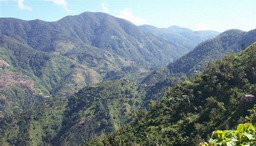A Year in the life of a Jamaican Blue Mountain coffee grower (Introduction part 2)Firstly, get your bit of land!! Very easy at the moment, as there are huge tracts of land, around here, available on extremely low cost, leases. All the lands above 5,000 are "owned" by the Forestry Commission, and kept in "forestry", but they do lease out some areas to grow coffee, but you cannot cut down any of the trees, and part of the lease compels you to plant more trees ( seedlings provided by the FC ). Then comes the hard work, clearing the land of the "bush", firstly cut it all back with a machete, then wait for it to start regrowing, and Zap the new growth with herbicides, timing is all important, or there is nothing to hold the soil together, and the storm rains, wash it all away!! Clear what is left with a machete, and then wait a few months, before repeating the process. The whole area is infested with a nasty foreign weed ( Polygonium chinense "red bush": a relative of Japanese Knot Weed, so if you know anything about that pernicious plant, you may have some idea of the problems! ) which needs 2 or even 3 "goes" to finally kill it. The setting up of a new coffee plantation, is not easy; these mountains are very steep, and it is virtually impossible to use any mechanised equipment ( bigger than a hand held, weed-whacker ) it all has to be done by muscle-power, alone. It is also very expensive, clearing and planting the land, the constant maintenance, and a 7 year wait for any return on the investment: and if my rather optimistic, calculations are only just "close", then around 10 to 12 years ( providing all is not destroyed by a hurricane ) to recover the investment, and start making a little "profit". An ideal project for some one like me; retired, and with a good pension income: but hardly a viable project for the vast majority of average, people. Starting from scratch, clear the land ( takes about a year ) before planting out the new coffee plants: and wait: 3 years, to first crop ( a few cup-fulls worth of beans ) 4/5 years to getting sufficient just for "own use" consumption ( and of course, a pack for Mum, back in England she will be 96 next year, but still enjoys a "good" coffee ), and in the range of 6 to 8 years, to full production ( weather willing!! ). Plantation maintenance, consists of keeping the heavy bush under control, whilst allowing small plants and flowers, to grow in the short grass. The young coffee plants need regular fertilizing, spraying ( insecticides, and fungicides ) and pruning. Plant the whole place, well spaced, with the shade plants the young coffee prefers: many of them are also "crop" plants, like Banana, the whole range of Citrus trees, Guava, and many others. For the very young coffee plants, a useful shade plant, is Co-Co: a plant with very large leaves, that grows quickly, to 4 or 5 feet high, and the tubers are part of the local, staple diet, so you get the benefit of the shade, and a food supply! What would be the best trees, which also produce a load of fruit, Mango, and Avocado, just do not grow well in the mountains, and if they do grow, produce almost no fruit ( too cool and damp for them ) Coconut palms, will grow up here, but they are small, and stunted, and never produce any nuts. For us, the most useful trees are bananas, and Citrus ( we have 3 varieties of Oranges; Grapefruit, Tangerine, Lemons and Limes; all of which grow well, and produce loads of fruit ). Apples, pears, plums, apricots, etc. are useless, as they just cannot cope with the climate, and the few that manage to grow up here, are little more than stunted, almost leafless, bushes. When I bought this plantation: it was very run down: it was, many years ago a proper coffee plantation: but over the years, with no one to care for it, slowly disintegrated: we had about 400 mature coffee bushes ( the land should take 3,500 ) and all but 60 of those were, and still are, well "over"grown: but still produce some coffee: they will be cut out, and replaced, as the newly planted suckers, start to produce, and take over the "cropping", from them. As we get the last of the coffee crop picked, wander around the plantation, and dig up any self-seeded "suckers" as they are referred to by the locals; there are always a few ripe coffee berries on the coffee bushes, and we pick them ( talking of a few dozen berries per month, NOT worth processing ) which are planted in pots, and are 3 to 4 inches high, in a several weeks. When the seedlings are about 12 inches high ( about 9 months ) and have at least 4 pairs of leaves, they are planted out, with a big handful or two, of well matured compost, in each hole. October onwards, after the worst of the storms are likely to be over, and the rains are fairly regular, into March. Despite all our care, we lose around 20% of the new seedlings, from each planting. We plant them 872 to the acre ( topography allowing ) 10 feet by 5 feet apart. A well pruned bush is about 5 feet in diameter, so in one direction they are just touching each other, in the other direction, there is a gap, to allow access to the bushes, for maintenance, and picking.
We collect and plant 2 or 3 year old coffee bushes ( when we can find them ) from the places the local coffee factory dumps their trash, and there are a lot of good coffee beans, that get left in the trash! The transplanting, puts them back a few months, but overall we gain a couple of years growth, over planting from seeds! Coffee only flowers and produces beans, on the old growth; and from seed to first bean, 3 or 4 years, and about 7 to 8 years before it comes into "full" production: the bush itself, if carefully looked after, and properly pruned, will produce for 25 to 30 years, before needing replacement. Even on a fully mature, well run plantation, around 10% of the coffee bushes will be new, or young bushes. Leave the bushes unpruned, and they grow really tall ( 20 or even 30, feet high ) producing few berries, and very difficult to pick!! The pruning is very much an "art form", and I leave that part of the work, strictly to my very experienced, plantation worker: the perfectly pruned bush, has 4 ( not 3 or 5 ) side shoots, and the "top shoot", and as soon as the bush grows up, and fills out, most of the ( non bearing ) new growth is pruned off, height is limited to about 6 feet, to allow the pickers to get to all the ripe beans. Because the coffee only bears on old growth, a careful balance to allow just sufficient, new growth, each year: the perfectly pruned coffee bush, looks like an example of topiary. A single, mature coffee bush will yield about 6 pounds of cherry-berries, each year ( processes to about 12oz. of "A" grade, and another 6oz of lower grades of coffee ); one coffee bush we had, produced nearly 20 pounds of cherries, in one year, and promptly died!! We are currently having to use chemical fertilizers, but as time goes on, and the compost heaps "mature", we will be going to a "semi-organic" regime: just using the chemical fertilizers, to "top up" the compost!! I would love to be able to go fully organic, but it is not possible: the extra input costs, far outweigh the premium on the coffee; it might be a "hobby", but I do need to cover the costs! Organic fertilizer is cheap, and easy to obtain ( chicken manure, and the waste from the coffee factories ) but it is the transport costs, that "kill" the idea: it costs about 10 times the price paid for the manure, to get a 5 ton lorry load, up here; which makes it around 3 times the price, of chemical fertilizer, which I can easily carry in own car. Then there is the problem of shifting several, 5 ton lorry loads of chicken shit, from road, to the coffee bushes! There is just so much, all conflicting, advice on how the fertilize coffee: the Coffee Board recommend using 2 pounds of chemical fertilizer, per bush, per year, in two applications!! WOT rubbish!! As any gardener knows, several small applications of chemical fertilizer, spaced several weeks apart, will give the plants a far better "feeding regimen", and using a quarter of the amount of fertilizer! Mix it with home made, compost, and reduce the total quantity, by half, again. BUT:- one has to balance the cost of the fertilizer, against the labour costs, of making several applications, through the year, especially if you are running a large plantation. For me to do it the way the Coffee Board, suggests; would waste 90% of my ( expensive! ) fertilizer, the coffee bush just cannot absorb that much fertilizer, as it dissolves in the rain: the majority of it just washing down the slope, feeding the coffee in the farm below mine, before getting into the river, and causing all manner of problems to the environment, downstream. The soil on my plantation, is relatively poor in certain nutrients; the most noticeable being Nitrogen ( essential for plants to put on vegetative growth ) and over the years the soil has been "drained" of most of the Phosphorus, and Potassium ( essential for plants to flower, and produce seeds ): these are the elements that we have to supply with the chemical fertilizers: but, as the needs of the plants vary through the year, we can, with several applications, vary the proportions of the various elements, to best improve the coffee crop; as the coffee berries are developing, cut back on the Nitrogen, limiting the vegetative growth, and getting the plant to put more energy into the berries, improving both the quality, and quantity, of the coffee! Chris, my farm worker, a local born and bred; but is totally illiterate: and he has no option but to rely on local "lore" and "wisdom", to grow the coffee; he is extremely reluctant to accept ANY changes in the way he has always grown coffee: rather than just "ask" him to do things differently, I have to ORDER him to do it my way, and even when he sees the improvement in the coffee ( and the bank account!! ) he refuses to admit it; when asked about it, a few unintelligible mutterings, before he changes the subject, or walks away! This is getting boring!! SO how about a Jamaican recipe: very simple and tasty: mash up a few, almost, over-ripe bananas, mix with the very cheapest Vanilla ice cream available, add a good slug of Rum, and give it a quick twirl in the food processor, back in the freezer for a while; and eat with a tropical fruit salad mixture. Robin Plough, friend of www.coffee4dummies.com For questions about JBM, mail to: Этот e-mail адрес защищен от спам-ботов, для его просмотра у Вас должен быть включен Javascript |
Growing: Part 2
Growing: Part 2


 I look out from my balcony, across the gully, and there is a massive coffee plantation; owned by Wallenford coffee Co. ( a Govt owned Company ) very seriously "mashed up" by a massive hurricane, 30 odd years ago, and only recently, are they replanting some hundred acres. We can sit up here, overlooking most of the newly planted area: and just cannot work out what they are doing: the coffee seedlings, planted far too close together, all that will happen is that the bushes will grow into each other, reducing the light that gets to the bushes, reducing both the quantity of the crop; and with smaller beans, reducing the quality: and, makes the pickers job that much more difficult ( but: in the Jamaican way of thinking, what does that matter?? as they are paid by the poundage, they pick!! ).
I look out from my balcony, across the gully, and there is a massive coffee plantation; owned by Wallenford coffee Co. ( a Govt owned Company ) very seriously "mashed up" by a massive hurricane, 30 odd years ago, and only recently, are they replanting some hundred acres. We can sit up here, overlooking most of the newly planted area: and just cannot work out what they are doing: the coffee seedlings, planted far too close together, all that will happen is that the bushes will grow into each other, reducing the light that gets to the bushes, reducing both the quantity of the crop; and with smaller beans, reducing the quality: and, makes the pickers job that much more difficult ( but: in the Jamaican way of thinking, what does that matter?? as they are paid by the poundage, they pick!! ).


